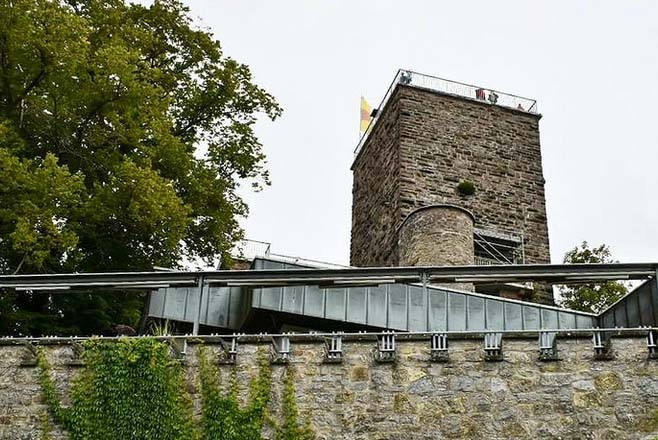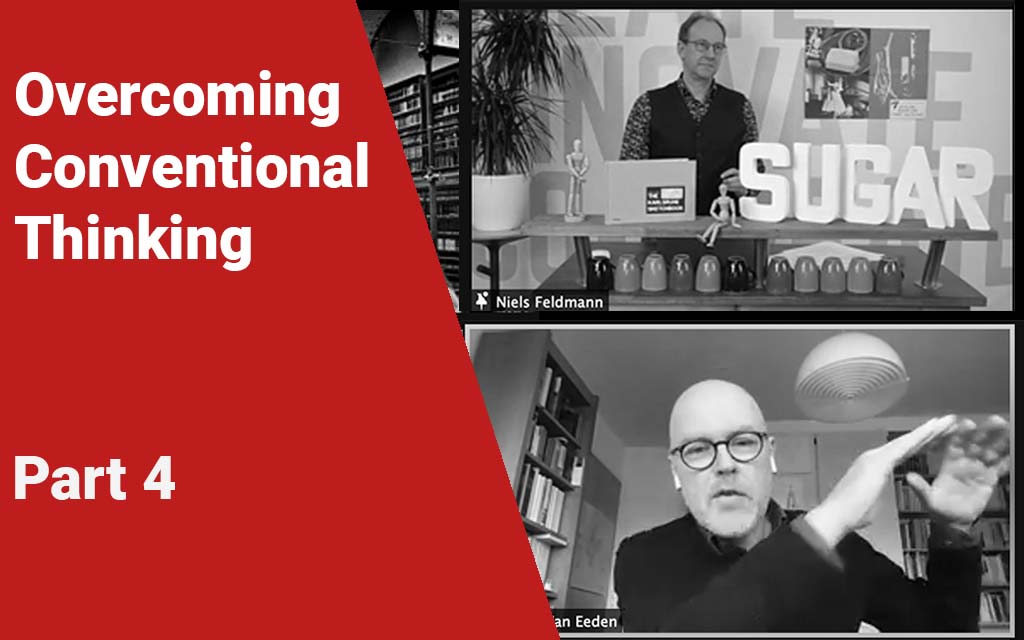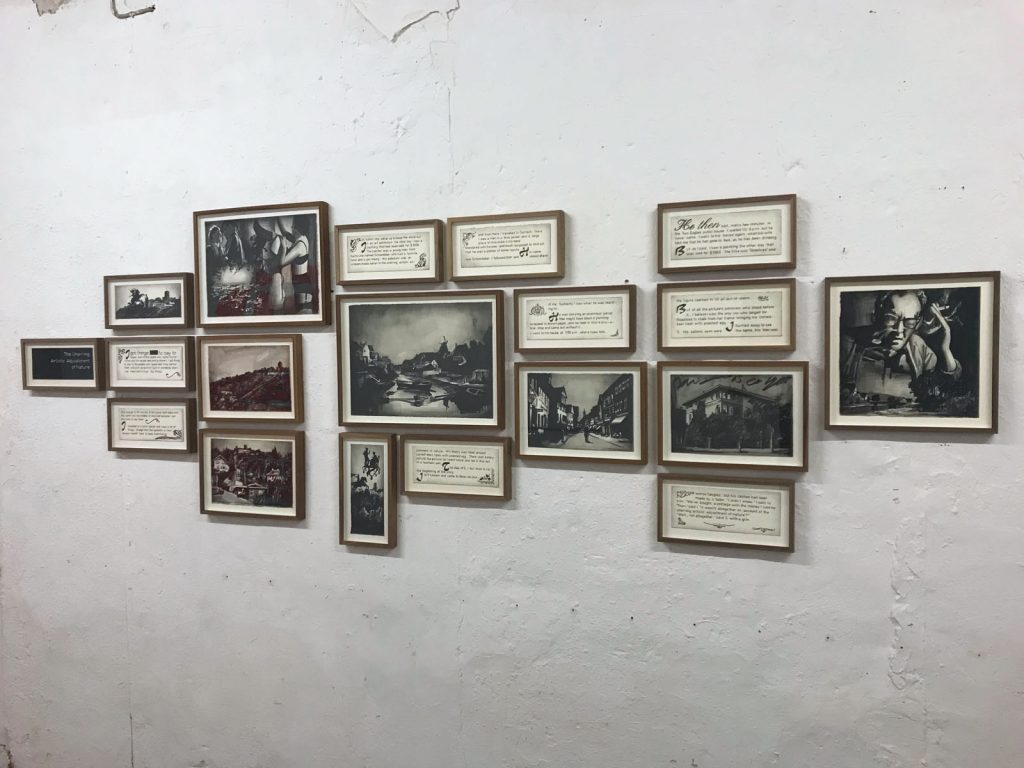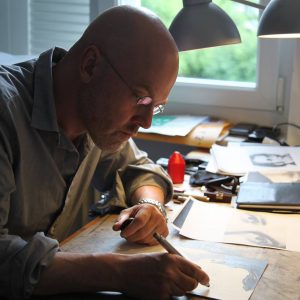Teaching creativity
In this part we continue our conversation with contemporary artist Marcel vann Eeden. We talk about how he as a professor at the Karlsruhe State Academy of Fine Arts creates assignments for his students that help them in covercoming conventional thinking (minutes 16:54 – 28:55 in the video).
The right assignments
NF: Marcel, you are also a professor and as such you are educating younger artists in finding their own style and being creative. A while ago, you told me about a project called “The Tower” (“Der Turm”). Can you tell us a bit more about this project and how you used it in education?
MvE: As outlined, I work from a problem definition that I must solve within my boundaries or on the soccer field of my parameters. And, I think, for some students it’s good to be creative in the same way. That’s why I gave them an assignment to go to a very famous tower on top of a mountain next to Karlsruhe.
For my students it was interesting to find out that it’s not about going to the tower and painting it or being very literary about it. Instead, they needed to be more creative and find new ways to depict this tower or create something related without merely painting it. For some it was interesting to develop a creative process that starts in their brains. This corresponds with what I said about complete freedom: It sometimes works better with students to give them such an assignment than to ask them to just start painting.

Does familiarity with a subject matter?
RW: But it’s about exploring something that is entirely familiar to them or at least they think so.
MvE: Yes, this applies to many of them, but not to all. We have also a lot of students from Asia who just arrived, and they don’t know the tower yet.
RW: In the way they worked and the work they produced, did you see any difference between people who already knew the tower very well and those to whom it was new?
MvE: No, I don’t think so. It’s more the creative process in your brain that leads to strange or different outcomes. And it’s difficult. I have to remember the results. Maybe it’s because a lot of the students are very young and have little experience in making something really new. That’s what they’re learning through an assignment like this.
Finding an individual approach
NF: How many of your own rules and approaches do you convey to your students?
MvE: I show them how I approach such a task, but I don’t expect them to go to the archives and find old photos and stories with old photos. That’s not the idea. Some students made abstract paintings using dots depicting the complete measurements of the tower. That’s a completely different creative approach and it’s also very good.
Another important aspect is to distance yourself from the assignment. As a student, of course, you have to fulfill it. But the most creative students do their own thing and try to elegantly circumvent the assignment. They still deliver what I have asked for but also create their own work. From my point of view, it is essential to learn how to bypass the rules.
RW: When you set an assignment, do you then execute it yourself in parallel to the students?
MvE: In this case, I did it, yes.
Mutual inspiration
CT: You catalyze creativity in your students. In return, are the students also catalyzing creativity in you? In other words, is there any inspiration that you take from your students or your role as a teacher for your own artistic work?
MvE: The inspiring thing is that you have to go back a lot of steps together with your students. That’s also interesting for yourself and your own work. From my perspective, creativity requires a lot of experience, but many students are very young for an art academy – as young as 18 or even 17 years of age. That’s too young for students to be an artist. I don’t think there are many prodigies in the visual arts. With 18 you have hardly been able to collect enough experiences to be creative. That’s a bit of a problem with younger students, but with the older ones you’re more on the same level. The best part about being an art professor is taking all these steps back, picking up the students where they are and trying to take them to a new level.
The role of experience
CT: So, going through the process with them makes you think about your own process in different ways.
MvE: Yes, it means rethinking your process over and over again – that’s the good thing about it.
I have read the book ‘Our Creative Brains’ by the Dutch neurobiologist Dick Swaab. I mean, you don’t invent new colors, you don’t invent new water, it’s all there. When being creative your brain almost autonomically combines existing elements and the outcome is something new. In doing so, it builds on all kinds of experiences you’ve already had. And that’s why I think it is conducive for art students to be a little bit older and having collected more experiences than the typical 18-years old who still lives at home with the parents.
CT: So, the more variance you have in life experience, the more inspiration you have in your brain? Information that is lying dormant will come together in different ways?
MvE: Yes, this comes even before style gets important. Before you develop a style, you come to content. The number one is you must have something to say. In art school, you learn how to say something, but you don’t learn what you have to say. Because what you have to say comes completely from within and that’s based on your life experience.
Recap & Take-Away
In this part Marcel share some experiences and perspectives on educating young artists in their creative process:
- [Take-Away] Re-Define the challenge: The direct response to the actual challenge (create an artwork about a specific tower) is not likely to lead to an original result. In fact, redefining the innovation challenge is also an important step in the Design Thinking approach (compare Methodology section).
- [Take-Away] Alienate the given problem: In Design Thinking we usually redefine the challenge by focussing on a specific target group and/or taking certain constraints or trends that are important for the target group into account. The paradigm of the artists is different. They want to convey a message in an artistically new way. Translating the measurements of the tower into dots means to modify the challenge through abstraction.
- [Take-Away] Add something that is important to you: Marcel states that the best students „do their own thing“ but still deliver the task. Hence, they add something that is important to them as an additional associative element to the challenge.
- [Take-Away] Experience facilitates creativity: By referencing the book ‚Our Creative Brain‘ Marcel points out that experience contributes to having an own message and sensing connections between the message and other elements. From this we can deduce that the availability of in-depth knowledge and a broad horizon of experience in an innovation team promotes creative results.
Marcel van Eeden (*1965, Den Haag/NL)
Lives and works in Den Haag/NL, Karlsruhe/DE, Zürich/CH
Professor at the State Academy of Fine Arts Karlsruhe since 2014
Rector of the State Academy of Fine Arts Karlsruhe from October 2021
Web: https://www.marcelvaneeden.nl/
Galleries:
Sprueth Magers, Berlin | London | Los Angeles
Galerie Barbara Seiler, Zurich
In Situ/Fabienne Leclerc, Paris



